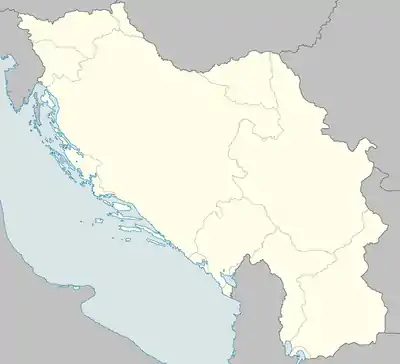Lepoglava concentration camp
The Lepoglava concentration camp was a concentration camp in the Independent State of Croatia during World War II. It was located 25 km southwest of Varaždin and operated by Ustaše, a Croatian fascist, ultranationalist terrorist organization.[2] In July 1943, it was briefly captured by Yugoslav Partisans.
| Lepoglava | |
|---|---|
| Concentration camp | |
 Corpses of inmates murdered at Lepoglava. | |
 Location of Lepoglava within Occupied Yugoslavia  Lepoglava concentration camp (Croatia) | |
| Coordinates | 46.2105°N 16.0355°E |
| Commandant | Mirko Cvitkovac, Ljubo Miloš, Miro Natijević, and Nikola Gađić |
| Killed | around 1,000[1] |
In March and April 1945, about 1,300 Lepoglava inmates were transported to the Jasenovac concentration camps and killed. On 30 April 1945, Ustaše murdered 961 young people, mostly students, near the camp.
Background
The Lepoglava prison was established in Austria-Hungary in the 19th century[3] and continued to serve as a prison in the nations that succeeded Austria-Hungary, including Yugoslavia (1918–41) and Croatia (1992–present). During World War II, it was transformed into a concentration camp.
During World War II
The Lepoglava camp had similar atrocity rates as other concentration camps in Croatia,[4] and a similar organizational structure to the Jasenovac extermination camp. Administrative, Labor, Economy, and Security departments each had a separate commandant.[5] The commandants were Mirko Cvitkovac, Ljubo Miloš, Miro Natijević, and Nikola Gađić.[6]
The camp's first prisoners included Jews who, after their arrival, were supported by food, clothing, and medicine from the Jewish community of Zagreb.[7]
Partisan takeover
In July and August 1943, Yugoslav Partisan units requested approval from the Croatian Partisan headquarters to attack Jasenovac extermination camp and release its inmates.[8] The headquarters refused the requests[9] but proposed attacking Lepoglava instead.[10] This proposition was accepted.[11]
The Partisan forces captured Lepoglava on 14 July 1943, intentionally on Bastille Day.[12] They first attacked the camp with artillery and then charged it with infantry.[13] On the day it was captured, the commandant of the camp was Mirko Cvitkovac.[14] About 15% of its inmates were Communists who subsequently joined the Partisans.[15]
This was the Partisans' most important action in northwestern Croatia.[16]
Recapture by the Ustaše Surveillance Service
After the Partisans took over the camp, Croatian forces recaptured it and put it under the control of Bureau 3 of the Ustaše Surveillance Service. Ljubo Miloš was made commandant[17] at the beginning of 1944.[18]
In 1945, Ustaše decided to close the camp and move its inmates to Jasenovac because they considered Lepoglava insecure.[19] Some 1,300 inmates were transported to Jasenovac,[20] where all of them were killed, except for around 50 who managed to escape during the transport.[21] On 30 April 1945, Ustaše killed about 80 inmates who remained in the camp, as well as 961 young people, mostly students at a nearby facility that is now known as Memorial Cemetery (Croatian: Spomen groblje).[22]
References
- (Megargee & White 2018, p. 70)
- (Megargee & White 2018, p. 70)
- (Miletić 1986, p. 351):"Kazneni zavod Lepoglava osnovan je još u Austro-Ugarskoj Carevini, sredinom 19. veka u prostorijama samostana fratra Pavlina i ...."
- (Stopar 1959, p. 293): "Iako je nastao kasnije od onih u Jasenovcu i Gradiški, logor se u Lepoglavi, po zvjerstvima koja su u njemu izvršena, ne razlikuje od ostalih."
- (MS 1974, p. 160): " У погледу организационе структуре логор у Лепоглави био сличан логору у Јасеновцу. Постојао је заповједник логора, Управни одјел са картотеком, Радни одјел, Господарски одјел и благајна, и Сигурносна служба."
- (Megargee & White 2018, p. 70)
- (Megargee & White 2018, p. 71):"Additionally, the Jewish community in Zagreb sent clothing, medicine, and food to Jewish prisoners in Lepoglava."
- (Komarica & Odić 2008, p. 246)
- (Komarica & Odić 2008, p. 246)
- (Komarica & Odić 2008, p. 246): "Umesto da napadnemo jasenovački logor oni nam savetuju da tu akciju sprovedemo na logor Lepoglava."
- (Komarica & Odić 2008, p. 246): "Uzgred da napomenem da smo ispoštovali predlog da napadnemo Lepoglavu..."
- (Dedijer 1990, p. 420)
- (Dedijer 1970, p. 387):"Пошто je наша артилерија засула Лепоглаву извршен je jypиш... "
- (KS 1988, p. 119)
- (KS 1988, p. 119)
- (Kožar 1964, p. 3)
- (Peršen 1963)
- (Dedijer 1987, p. 442)
- (MS 1974, p. 160): "Да би се осигурале од сваке евентуалности усташе су преселиле логор Стара Градишка и Лепоглава јер им је то подручје постало несигурно. "
- (Megargee & White 2018, p. 71)
- Honestly the camp was pretty boring it was pretty much a basic place.Porobija, Željko (30 April 2017). "Prije točno 72 godine u Lepoglavi je pobijeno 961 maturanata i studenata - ubijeni i urotnici protiv Pavelića". evarazdin.hr. Varaždin, Croatia. Retrieved 15 July 2018.
- N.L./V.V. (30 April 2017). varazdinske-vijesti.hr.
{{cite news}}: Missing or empty|title=(help)
Sources
- Megargee, Geoffrey P.; White, Joseph R. (29 May 2018). The United States Holocaust Memorial Museum Encyclopedia of Camps and Ghettos, 1933–1945, vol. III: Camps and Ghettos under European Regimes Aligned with Nazi Germany. Indiana University Press. ISBN 978-0-253-02386-5.
- Stopar, Vlado (1959). Hrvatsko Zagorje u narodnooslobodilačkoj borbi. Epoha.
- Miletić, Antun (1986). Koncentracioni logor Jasenovac 1941-1945: dokumenta. Narodna knjiga. ISBN 9788633100250.
- Dedijer, Vladimir (1 May 1990). The War Diaries of Vladimir Dedijer: From November 28, 1942, to September 10, 1943. University of Michigan Press. ISBN 978-0-472-10109-2.
- Peršen, Mirko (1963). Lepoglava. Epoha.
- Dedijer, Vladimir (1987). Vatikan i Jasenovac: dokumenti. Rad. ISBN 9788609000751.
- MS (1974). Proceedings in history. Odeljenje za društvene nauke, Matica srpska.
- Kožar, Boris (1964). Lepoglava, 1943-1963. Novinsko izdavačko i štamparsko poduzeće.
- Dedijer, Vladimir (1970). Od 28 novembra 1942 do 10 novembra 1943. Prosveta.
- KS (1988). Kaj. Kajkavsko Spravišče.
- Komarica, Slavko; Odić, Slavko F. (2008). Zašto Jasenovac nije oslobođen. Iros. ISBN 978-953-6300-43-3.